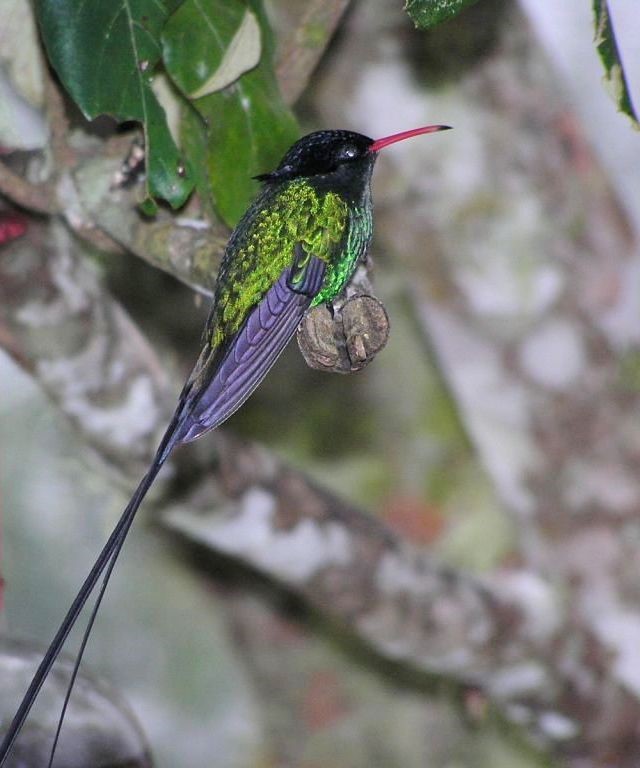Birdfinding.info ⇒ The national bird of Jamaica, popularly known as the Doctor Bird, is one of its commonest woodland and garden species. It is easy to find at most of the frequently visited birdwatching sites, especially at Rocklands Bird Sanctuary, where it perches on visitors’ fingers. Other sites where it can reliably be seen at close range include Marshall’s Pen, Green Castle Estate, Hope Gardens, and Hardwar Gap.
Red-billed Streamertail
Trochilus polytmus
Endemic to Jamaica, where it is common in most habitats throughout the island. Uncommon east of the Blue Mountains, where Black-billed Streamertail largely replaces it.
Identification
Male is spectacular: mostly glittering green with two extraordinarily long tail feathers, projecting up to 7″ past the other tail feathers. Its red bill and black cap contrast with the bright green underparts.

Red-billed Streamertail, male with underparts appearing blackish due to the lack of iridescent reflection at this angle. (Green Castle Estate, Jamaica; February 16, 2017.) © Carole Rose
Differs from male Black-billed Streamertail in having a thicker, mostly reddish (often bright-red), black-tipped bill and typically an emerald green sheen on its body plumage, especially the underparts. Usually appears more robust than Black-billed, especially in the chest.

Red-billed Streamertail, male, lacking long streamers, but showing characteristically emerald-green throat and sharply contrasting black cap. (Marshall’s Pen, Jamaica; March 2, 2017.) © Kyle Elliott

Red-billed Streamertail, male. (Rocklands Bird Sanctuary, Jamaica; February 2012.) © Ignacio Yúfera
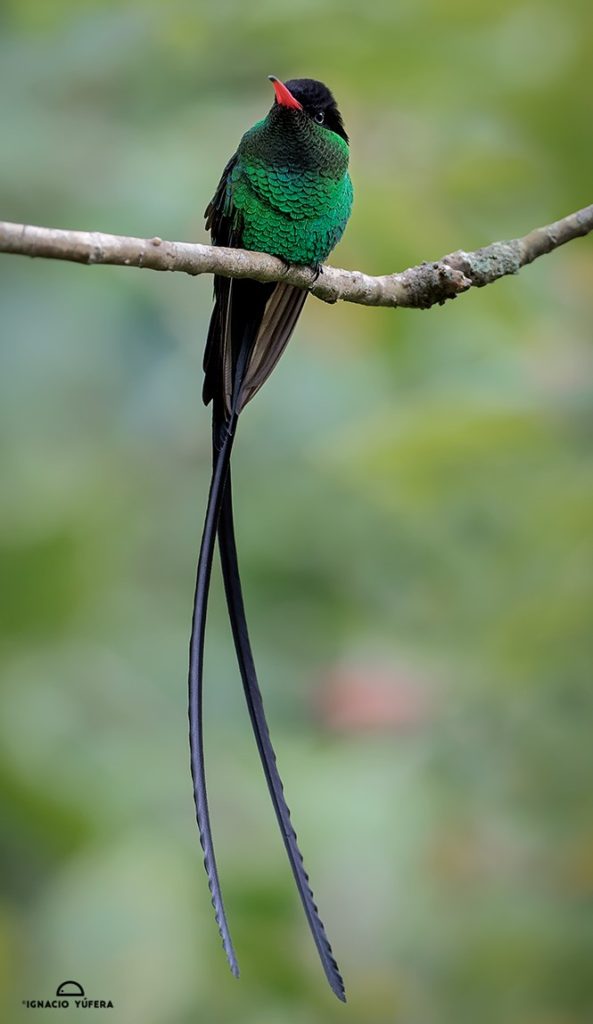
Red-billed Streamertail, male. (Rocklands Bird Sanctuary, Jamaica; February 2012.) © Ignacio Yúfera
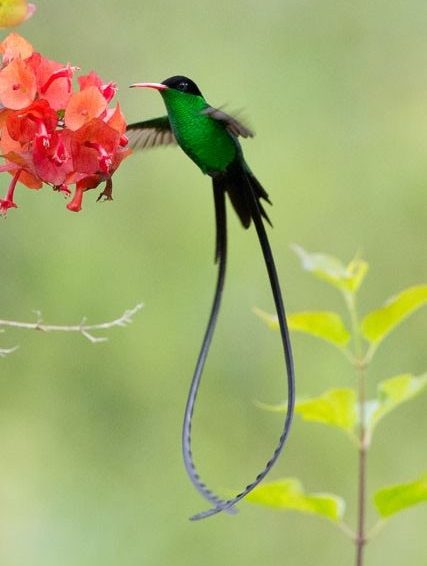
Red-billed Streamertail, male. (Silver Hill Gap, Jamaica; February 2014.) © Tom Davis
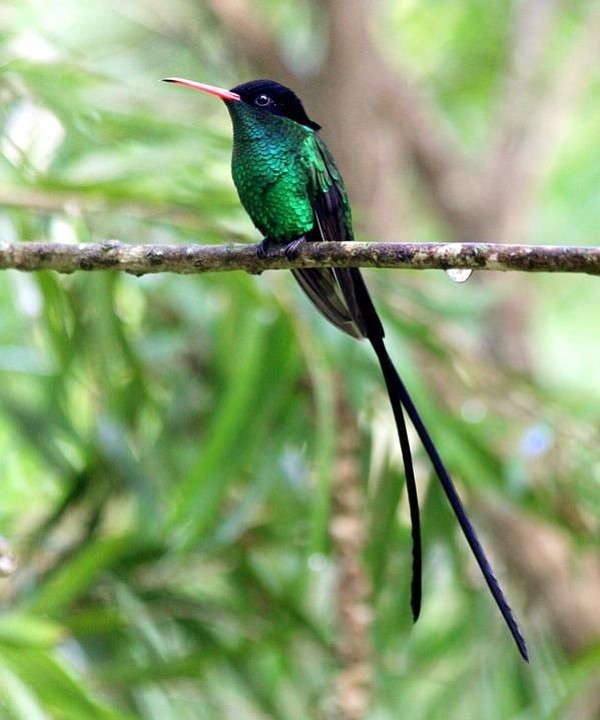
Red-billed Streamertail, male showing unusually bluish-green sheen on throat. (Rocklands Bird Sanctuary, Jamaica; February 2017.) © Eric Moore
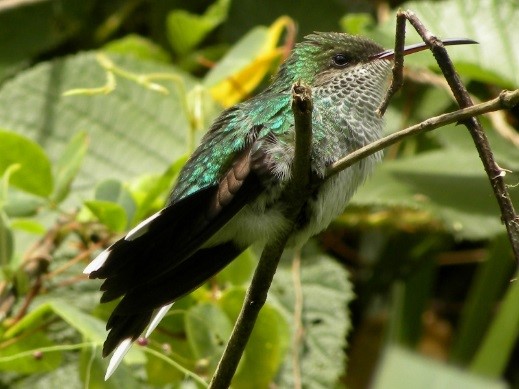
Red-billed Streamertail, female showing the distinctive graduated and notched tail shape and a partly reddish bill. (Mona, Jamaica; December 31, 2010.) © Jan van den Broeck
The female is extremely similar to female Black-billed Streamertail, and not always identifiable in the field. Identitification is usually presumed based on location.
Both female streamertails have fairly long tails compared to females of other species, with a peculiar shape and pattern. The tail is notched in the center, and the outer feathers are graduated (the outermost are shorter) and extensively tipped white.
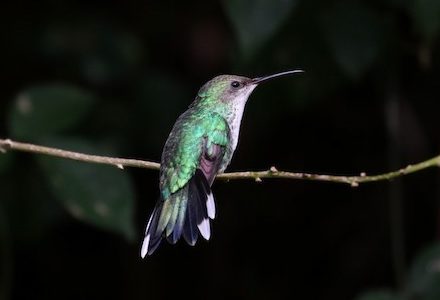
Red-billed Streamertail, female showing the distinctive graduated and notched tail shape and an apparently all-black bill. (Hardwar Gap, Jamaica; February 19, 2018.) © Beatrice Henricot
Black-billed has a slightly thinner, all-black bill. Female Red-billed’s bill can also appear all-black, but usually shows a dull reddish tone toward the base.
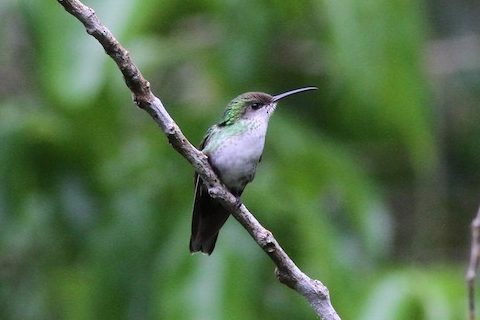
Red-billed Streamertail, female showing an apparently all-black bill. (Silver Hill Gap, Jamaica; March 10, 2017.) © Michael McCloy
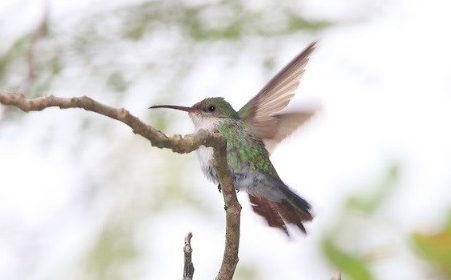
Red-billed Streamertail, female showing a partly reddish bill. (Stewart Town, Jamaica; February 18, 2018.) © Tim Avery
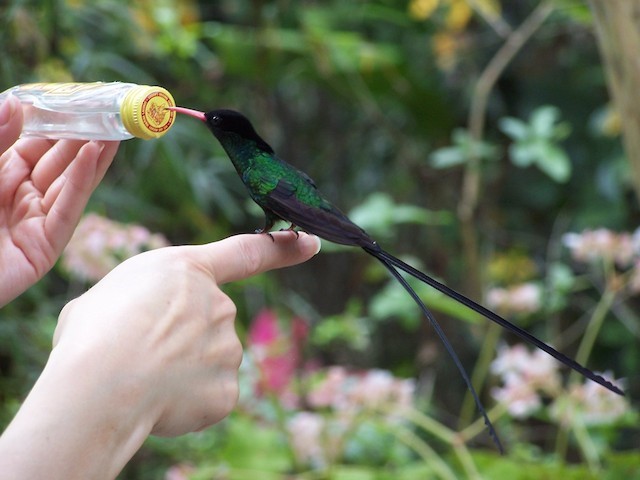
Red-billed Streamertail, male, hand-fed. (Rocklands Bird Sanctuary, Jamaica; March 5, 2011.) © Louis Imbeau
Notes
Monotypic species. Traditionally considered conspecific with Black-billed Streamertail, but the two differ in several ways and appear to recognize one another as separate species (see below).
Frontiers of Taxonomy: Why Are There Two Types of Streamertails?
Red-billed and Black-billed Streamertails share Jamaica, with Red-billed exclusively occupying most of the island except the easternmost 5% or so, where Black-billed predominates. They overlap to a limited extent, as small numbers of Red-billed occur within Black-billed’s tiny range. They are obviously very similar to one another, but also readily distinguishable by sight—at least in the bill color and general coloration of the males. Their vocalizations and mating displays also differ. More subtly, their bills differ in shape, as Red-billed’s is somewhat broader than Black-billed’s. Their overall measurements are close, but Red-billed averages slightly larger than Black-billed.
In light of the clear differences between them and their persistence as distinct forms, it is peculiar that they are widely regarded as conspecific: the Streamertail (Trochilus polytmus). As of August 2019, this remains the official classification of the pertinent taxonomic authority, the American Ornithological Society. It seems certain that the AOS will eventually recognize the two as separate species—this does not appear to be a close case by contemporary standards. The AOS’s anachronistic position is a vestige of “Lumping Fever,” which overwhelmed taxonomists in the 1900s but has gone out of fashion and is unlikely to return as long as biologists continue to value biological diversity.
Disagreement over the species status of Red-billed and Black-billed Streamertails raises a central issue in the delineation of species: the significance of interbreeding. The streamertails present an analytically clean example, almost as if they were a laboratory experiment designed to decompose this issue. They are extremely similar (similar enough to plausibly be one species), but also easy to tell apart (different enough to plausibly be two species). They are confined to the same island, where they occupy the same general habitats, but mostly in different locations, although no physical barrier separates them.
On the surface, the streamertails appear to be sibling species, western and eastern counterparts, but this conclusion is complicated by the fact that they have been reported to interbreed at least occasionally. Based on these reports, ornithologists governed by the “biological species concept” decided that the streamertails must be races of a single species. The “biological species concept” reduces the definition of a “species” to a set of organisms capable of producing fertile offspring. This is among the classic criteria for determining what constitutes a species, but it is inadequate to describe the dynamic diversity of the living world. Taxonomists who reflexively apply the concept seek evidence of any interbreeding and prioritize it above all other factors—though in cases such as the streamertails it becomes clear that this approach fails to comprehend the core issue of taxonomy: speciation.
Rigid application of the “biological species concept” to the streamertails shows how an exception can sometimes swallow the rule. Through reliance on a single factor, advocates of this approach ignore the main question: why are there two types of streamertails on Jamaica? Having coexisted in the same limited real estate for tens or hundreds of thousands of years while capable of interbreeding, why do they remain distinct? If they are the same species, then why have they not blended into a single gene pool? The answer must be either that they recognize one another as different so interbreeding is rare (i.e., assortative mating) or that their hybrids are disadvantaged and fail to propagate over many generations (i.e., natural selection), or both. Either response is tantamount to a description of speciation.
Contrary to the “biological species” analysis, occasional instances of interbreeding streamertails actually confirm their separateness by showing that the birds themselves experiment with their species limits. In other words, exceptional cases of hybridization prove that no merely circumstantial barrier prevents the two populations from merging, yet these populations have remained distinct through the millenia. So evidently the distinction between them is intrinsic and the inescapable conclusion is that they are separate species: Red-billed and Black-billed Streamertails.
References
Brokaw, J. 2013. Streamertail (Trochilus polytmus), version 1.0. In Neotropical Birds Online (T.S. Schulenberg, ed.). Cornell Lab of Ornithology, Ithaca, N.Y. https://doi.org/10.2173/nb.stream1.01.
eBird. 2018. eBird: An online database of bird distribution and abundance. Cornell Lab of Ornithology, Ithaca, N.Y. http://www.ebird.org. (Accessed November 1, 2018.)
Fogden, M., M. Taylor, and S.L. Williamson. 2014. Hummingbirds: A Life-size Guide to Every Species. HarperCollins, New York.
Haynes-Sutton, A., A. Downer, R. Sutton, and Y.-J. Rey-Millet. 2009. A Photographic Guide to the Birds of Jamaica. Princeton University Press, Princeton, N.J.
Raffaele, H., J. Wiley, O. Garrido, A. Keith, and J. Raffaele. 1998. A Guide to the Birds of the West Indies. Princeton University Press, Princeton, N.J.
Schuchmann, K.L., and G.M. Kirwan. 2017. Red-billed Streamertail (Trochilus polytmus). In Handbook of the Birds of the World Alive (J. del Hoyo, A. Elliott, J. Sargatal, D.A. Christie, and E. de Juana, eds.). Lynx Edicions, Barcelona. https://www.hbw.com/node/55433. (Accessed November 12, 2017.)
